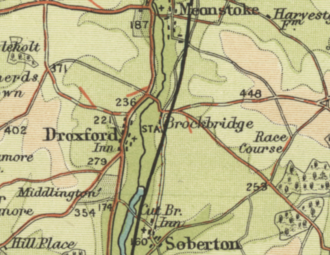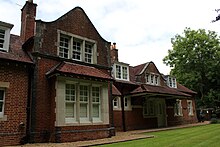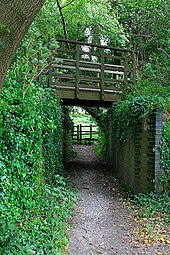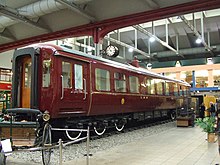Droxford railway station
[A] The railway served a relatively lightly populated area, but was built to main line specifications in anticipation of it becoming a major route to Gosport.
In 1944, amid World War II, Droxford station was used by the Prime Minister Winston Churchill as his base during preparations for the Normandy landings.
Based in an armoured train parked in the sidings at Droxford, Churchill met with numerous ministers, military commanders and leaders of allied nations.
On 4 June 1944, shortly before the landings were due to take place, Free French leader Charles de Gaulle visited Churchill at Droxford, and was informed of the invasion plans.
[4] The village of Droxford (from the Old English Drokeireford, "dry ford") is situated on sloping ground on the west bank of the Meon, overlooking a broad flood plain.
[9][C] The Long Depression had by this time been underway for over 20 years, severely lowering agricultural incomes and allowing the LSWR to buy land along the Meon Valley cheaply.
[15] Over the following weeks compensation was paid to those people whose homes or land would be affected by the building of the station or the rerouting of roads,[G] and the LSWR was ready to proceed with construction.
[22] All the new stations for the line were of a very similar Tudor Revival design, built largely of red brick with Portland stone stonework, stained glass windows and lavatories in the shape of pagodas.
[22] In anticipation of the route potentially becoming a major main line the station had two very long 600-foot (180 m) platforms, capable of handling 10-carriage trains, connected by a wooden footbridge.
[28] Although the station building was complete, work was proceeding more slowly than anticipated on the construction of the railway line, and the proposed opening date of 25 March 1903 was missed.
[32] The Meon Valley Railway was eventually completed and inspected for fitness by the Board of Trade on 6 April 1903, and the line opened to passengers on 1 June 1903.
[29] The opening day was Whit Monday, a bank holiday; local residents were each allowed to take one journey free of charge to the next station in either direction.
[33] (The free fares were only valid for a single journey; those taking advantage of the offer were obliged either to pay for a return ticket, or to walk back.
[33] The railway proved successful, and the availability of convenient travel to London prompted the construction of large luxury homes on the undeveloped land to the south of the station.
[38] The increased popularity of holidays and a national shortage of rolling stock and skilled railway staff led the government to take drastic measures.
Following the outbreak of war the Meon Valley railway remained in passenger and goods use during the day, and at night was used by troop trains carrying soldiers to Southampton to be shipped to France.
[41][J] Portsmouth and Gosport, both major military facilities within easy reach of German aircraft, were expected to come under severe bombardment, and many children from these towns were evacuated along the line to the villages of the Meon Valley.
[41] As a potential strategic route the Meon Valley Line came under occasional bombing from German aircraft attempting to disrupt traffic to and from the Channel ports.
The royal train of the London, Midland and Scottish Railway, a T9 class locomotive hauling armoured carriages, pulled into the sidings at Droxford station.
[50][M] Although officially kept secret from local residents, it soon transpired that Winston Churchill had chosen the station as a secure base, to be near the coast and to the Allied command centre at Southwick House during the forthcoming Normandy landings.
[50] His reason for choosing Droxford is not recorded, other than its proximity to the Channel ports; there was local speculation that the site was chosen owing to its deep cutting into which the train could be repositioned should it come under attack.
[43] In the company of his secretary Marion Holmes, General "Pug" Ismay and South African prime minister Jan Smuts, Churchill was to remain in the carriage at Droxford for the next four days other than a few brief excursions.
[50] Eden was unimpressed, and was later to describe the train as a place where "it was almost impossible to conduct any business" owing to there only being one bath and one telephone, each of which was constantly in use by Churchill or Ismay.
[52] Later that night Dwight Eisenhower, from his nearby base at Southwick House, decided to postpone the invasion from 5 to 6 June owing to predicted bad weather.
[56] At 16 minutes past midnight the following morning, British glider troops attacked Pegasus Bridge and the American airborne landings in Normandy began shortly after.
[67] On 6 February 1955 a special train named The Hampshireman,[68] consisting of two locomotives hauling ten carriages, went on a circular journey leaving London Waterloo station at 9.45 am, passing through Pulborough and along the line from Pulborough to Petersfield via Midhurst which was also due to close the next day,[66] north from Fareham to Alton along the Meon Valley Railway, and back to Waterloo, passing through Droxford at about 3.20 pm without stopping.
[73] On 1 June 1961 Dr Richard Beeching became chairman of the newly formed British Railways Board, with a brief of returning the network to financial stability.
[76] The short stub between Alton and Farringdon Halt remained operational by goods trains until 13 August 1968, the last part of the Meon Valley Railway to close.
[79] A serious problem with vandalism arose at the site when the tracks were intentionally blocked and points jammed in an effort to derail vehicles, and on 4 May 1970 the Pacerailer prototype was burned out and badly damaged.
[79][O] Eventually British Rail closed the Knowle junction, ending the last connection between Droxford and the railway network, and the Southern Locomotive Preservation Society abandoned the site.












